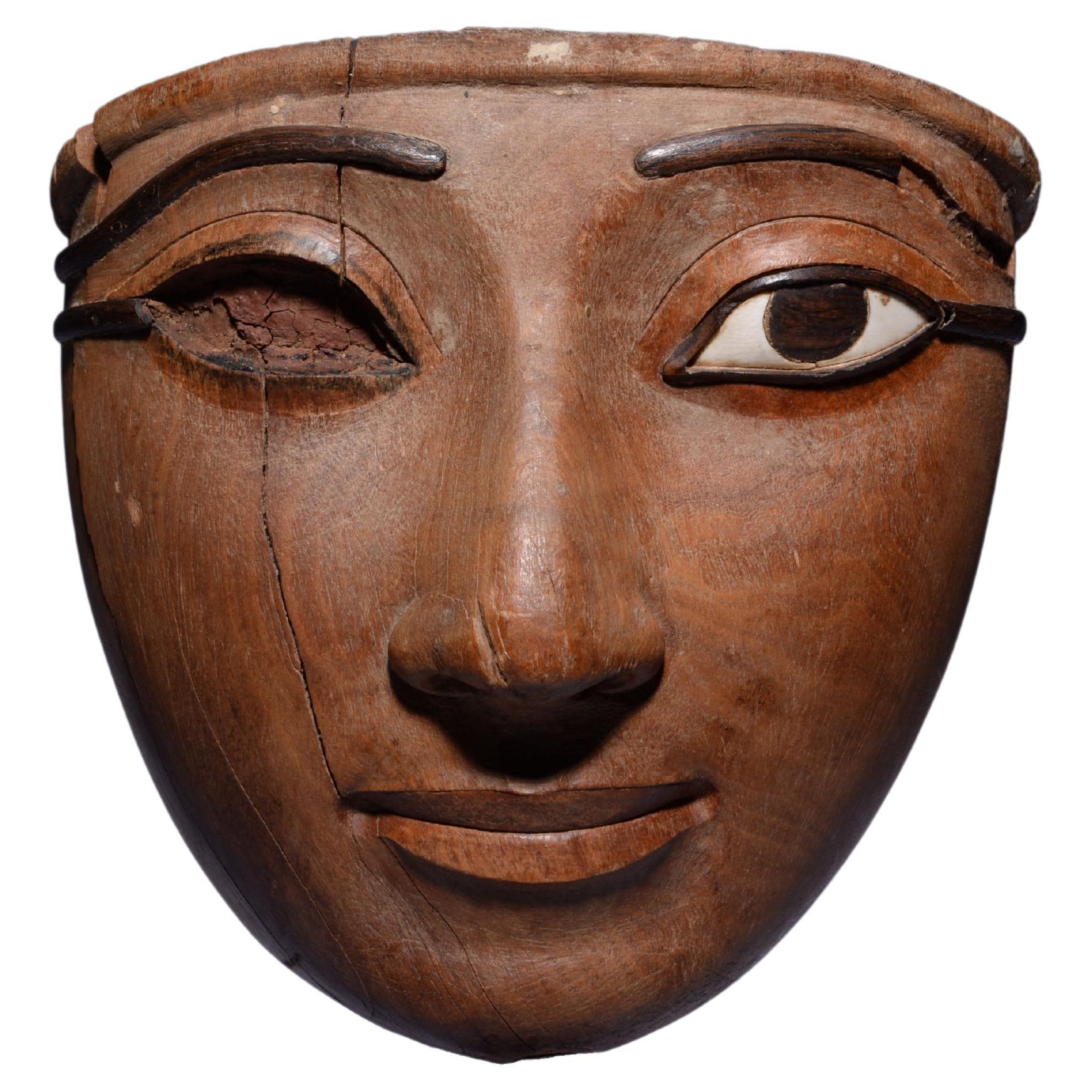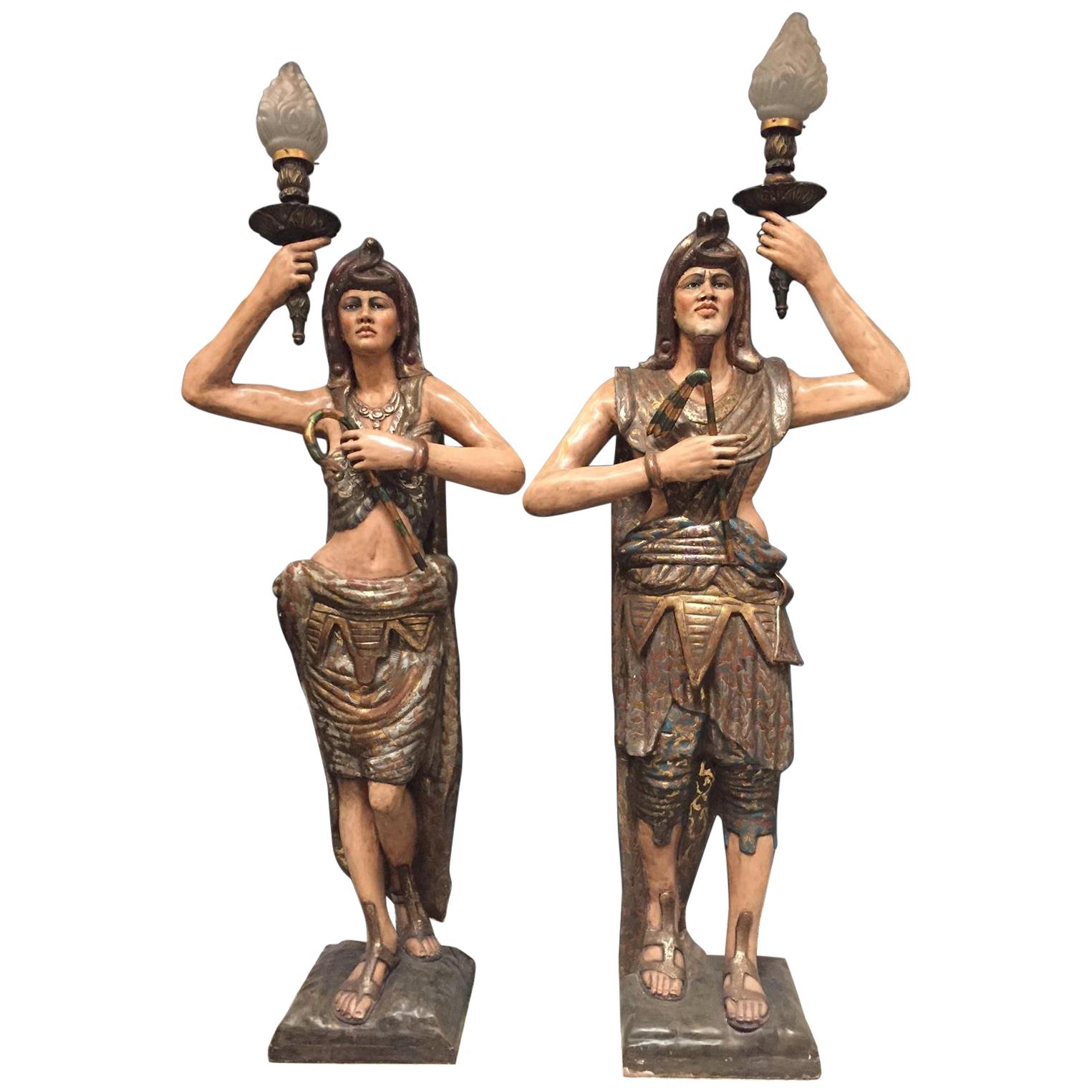Items Similar to Egyptian Carved Sarcophagus Figure
Want more images or videos?
Request additional images or videos from the seller
1 of 6
Egyptian Carved Sarcophagus Figure
About the Item
Egyptian carved and painted life size sarcophagus figure (19/20th Cent)
- Dimensions:Height: 88 in (223.52 cm)Width: 24 in (60.96 cm)Depth: 13 in (33.02 cm)
- Style:Egyptian (In the Style Of)
- Materials and Techniques:
- Place of Origin:
- Period:
- Date of Manufacture:circa late 19th or early 20th century
- Condition:Wear consistent with age and use.
- Seller Location:New York, NY
- Reference Number:
About the Seller
4.9
Recognized Seller
These prestigious sellers are industry leaders and represent the highest echelon for item quality and design.
Gold Seller
These expertly vetted sellers are highly rated and consistently exceed customer expectations.
Established in 1939
1stDibs seller since 2013
797 sales on 1stDibs
Typical response time: <1 hour
- ShippingRetrieving quote...Ships From: New York, NY
- Return PolicyA return for this item may be initiated within 2 days of delivery.
More From This SellerView All
- Chinese Carved Root Deity FigureLocated in New York, NYAsian Chinese (19th Cent) carved root figure of a standing DeityCategory
Antique 19th Century Chinese Figurative Sculptures
MaterialsWood
- Contemporary Carved Wood Figural SculptureLocated in New York, NYContemporary carved wood abstract figural sculpture.Category
20th Century American Modern Figurative Sculptures
- Large 19th c. Carved and Painted Carousel Style FigureLocated in New York, NYNineteenth century carousel style carved and painted figure, possibly representing a Turkish male, wearing a head wrap and mystical robes with hands raised towards his face.Category
Antique 19th Century Turkish Sculptures
MaterialsWood, Paint
- Austrian Egyptian Revival Style Bronze Sarcophagus Metamorphic Table LampBy Louis Vincent AronsonLocated in New York, NYAustrian Egyptian revival style metamorphic cold-painted bronze sarcophagus shaped table lamp in the style of Franz Bergman with a bronze doré female figure inside base. (Attributed to LOUIS V...Category
Antique Early 19th Century American Egyptian Revival Table Lamps
MaterialsBronze
- 19th Century Dutch Carved Monumental Wood Eagle Figure Seated on a PedestalLocated in New York, NYContinental 19th century Dutch life-sized carved wooden eagle figure with open mouth on square pedestal.Category
Antique 19th Century Dutch Folk Art Animal Sculptures
MaterialsWood
- Set of Monumental Bronze Egyptian FiguresBy Charles CameronLocated in New York, NYSet of 4 Russian (19th Century) monumental bronze Egyptian figures emblematic of the Months on painted bases after those by C. Cameron & M. Alexandrov for the Egyptian Vestibule at P...Category
Antique 19th Century Russian Neoclassical Sculptures
MaterialsBronze
You May Also Like
- Exceptional Egyptian Sarcophagus MaskLocated in London, GBExceptionally Fine Wooden Sarcophagus Mask Third Intermediate Period, 21st Dynasty, circa 1069-945 BC. Acacia wood, rosewood, hippopotamus ivory Masterfully carved from a single piece of fine-grained hardwood, the present mask is characteristic of the most exquisite funerary art made during the 21st Dynasty, and was probably commissioned for a particularly high-ranking individual. The oval face displays a gently smiling mouth with full, outlined lips, furrows at the corners and a bow-shaped philtrum. The straight nose with rounded nostrils, the cheeks full and fleshy and the large, almond shaped eyes with heavy lids and tapering cosmetic lines, set below long, sweeping eyebrows. Social collapse across the Mediterranean in the Late Bronze Age meant that the 21st Dynasty in Egypt was a period of great turmoil. Trade routes were disrupted, governments collapsed, and mass migration occurred. Economic scarcity meant that traditional funerary practices in Egypt were also affected, with a lack of material and financial resources leading to the reuse of preexisting material. As a result, during the 21st Dynasty, 19th and 20th Dynasty coffins changed ownership rapidly and were heavily recycled for new purposes. Tombs were also unmarked allowing them to be shared by many people. These new practices brought forth a shift in the understanding of funerary paraphernalia. No longer important objects owned forever by the deceased, they were now simply seen as short-term transformative devices, whose symbolic and ritualistic meaning could be appropriated for others. However, paradoxically, the art of coffin-making also reached new heights during this period, and many of the richly dec- orated “yellow” coffins, characteristic of the 21st Dynasty, are remarkable works of art in their own right. Indeed, knowing that coffins were being reused throughout Egypt, the Egyptian élite set themself apart by commissioning lavish sarcophagi decorated with the images and texts meant to help guide them to the afterlife, and which would otherwise have adorned the tomb walls. As coffins were the chief funerary element which now identified the dead and allowed them a physical presence in the world of the living, their quality and appearance were of the utmost importance. The traditional coffin ensemble was made of three parts: a wooden mummy cover, which laid directly atop the mummy, an inner coffin, and an outer coffin, both made of a lid and case. Additional decorative elements, such as masks, were carved out separately and later glued or pegged to the lids. After the completion of the painted decoration, the sarcophagus was covered in a varnish to give it its yellow colour. Gilding was sometimes used for the coffins of the high priests’ families, notably on parts representing naked skin, such as the face mask. However, some of the élite tactically avoided gilding altogether as to ensure that their coffin would not be looted. When manufacturing the inner and outer coffins, particular attention was paid to the woodwork. Displaying the skill of the carpenter, this type of funerary art has largely remained unparalleled throughout Egyptian history. The principal wood used to craft the present mask is Acacia nilotica. The evergreen Egyptian acacia was considered sacred and said to be the tree of life, the birthplace of the god Horus, as well as symbolic of Osiris, the god of the dead and resurrection. The modelling of the face in the wood is superb, but the inlays also help mark this mask out as exceptional. Inlaid eyes and eyebrows were extremely rare and reserved to the finest and most expensive coffins. Traditionally, eyes were made of calcite, obsidian, or quartz, and eyebrows of coloured glass paste or bronze. Here, the pupils, eyebrows, and cosmetic lines are inlaid with Dalbergia melanoxylon, a rare type of wood which belongs to the rosewood genus. In antiquity, however, it was known as Ebony of the Pharaohs, from the Egyptian word “hbny”, meaning dark timber, because of its black, lustrous appearance. An extremely dense and hard wood requiring significant skill to work with, ebony was a luxury material highly coveted by the pharaohs themselves, to make furniture, decorative and funerary objects. The wood was imported with great effort from the southern Land of Punt, most likely modern Sudan, Ethiopia, Djibouti, and Eritrea, alongside other luxury goods such as gold and ivory. A magnificent ebony throne, recovered in the tomb of King Tutankhamun, illustrates the incredible aesthetic potential of this material and why it was so highly valued by Egyptian royalty. Only élite members of Egyptian society could have afford- ed Ebony of the Pharaoh inlays for their funerary mask. The sclerae on the present piece were once both inlaid with hippopotamus ivory. Whiter than elephant ivory, this type of ivory is also denser, and more difficult to carve. The use of this luxury material, reputed for its gleaming appearance, enhances the lifelikeness of the eyes. For the Egyptians, hippopotamus ivory was imbued with magic powers. The hippopotamus was indeed both feared and venerated due to its aggressive behaviour. Whilst the male hippopotamus was associated with danger and chaos, the female was benevolent and invoked for protection, especially of the house and of mothers and their children, through the hippopotamus goddess Tawaret. Thus, not only was hippopotamus ivory used as an inlay and to make practical objects, such as combs and clappers, but it was also used to make talismans like apotropaic wands or knives. Made during a time of scarcity where few could afford made-to-order coffins, the present mask could have only belonged to one of the highest-ranking individuals in society. Undoubtedly one of the finest Egyptian coffin...Category
Antique 15th Century and Earlier Egyptian Egyptian Figurative Sculptures
MaterialsFruitwood, Hardwood
- Grand Tour Ancient Egyptian Style Carved Soapstone Figure of HorusLocated in Stamford, CTGrand Tour carving of Horus, ancient Egyptian god in the form of a falcon. Quite possibly much earlier in date, that is beyond my expertise. From a collection that did have ancient p...Category
Antique Late 19th Century Egyptian Egyptian Animal Sculptures
MaterialsSoapstone
- Set of Four Egyptian Antiquities, Pair of Sarcophagus Faience & Two FigurinesLocated in New York, NYThis captivating authentic Egyptian Faience set was realized in ancient Egypt circa 3100 BCE. It offers two sarcophagus figurines- suggestive of miniature versions of King Tut's tomb- hand finished in a beautiful turquoise hue (a glaze created by pulverizing the stone into pigment). Additionally, the set features two figurines (one representative of the Egyptian god Anubis), and the other seemingly a depiction of one of the ruler's as a young child also in a turquoise glaze atop volumetric rhombus plinths with tapered sides in a refined terra cotta hue. Full of historical importance (and stunning as stand alone objects) this collection of Egyptian antiquities...Category
Antique 15th Century and Earlier Egyptian Egyptian Figurative Sculptures
MaterialsFaience
- French Egyptian Revival Carved Wood Figure of King TutankamunLocated in Stamford, CTA carved standing figure of King Tutankamun wearing the royal headdress topped by the double uraeus. This compelling carving depicts the slender boy king standing with arms crossed h...Category
Early 20th Century French Egyptian Revival Figurative Sculptures
MaterialsWood
- Pair of Italian Polychromed and Painted Egyptian style figural torcheresLocated in Cypress, CAImpressive opposing pair of Venetian polychromed and paint decorated Egyptian style figural torcheres. Early 20th century. A life-size Nubian man and woman, each dressed in traditio...Category
Early 20th Century Italian Egyptian Torchères
MaterialsWood
- Grand Tour Egyptian FigureLocated in Hudson, NYA rather monumental plaster figure of a seated Egyptian scribe realistically faux painted as granite. Sold at a Christies South Kensington Grand Tour a...Category
Early 20th Century Unknown Statues
MaterialsPlaster
Recently Viewed
View AllMore Ways To Browse
Egypt Egyptian
Egypt Sculpture
Egyptian Wood
Carved Painted Figure
Carved Egyptian
Egyptian Figure
Egypt Sarcophagus
Egyptian Sarcophagus
Figurative French Deco
Stone Specimen
Modern Furniture 1918
1930s German Art
French Bronze Figurative Sculpture 19th Century
Forms Surfaces Bronze
Brass Figures
La Period Furniture
Austrian C
Forms And Surfaces Bronze





